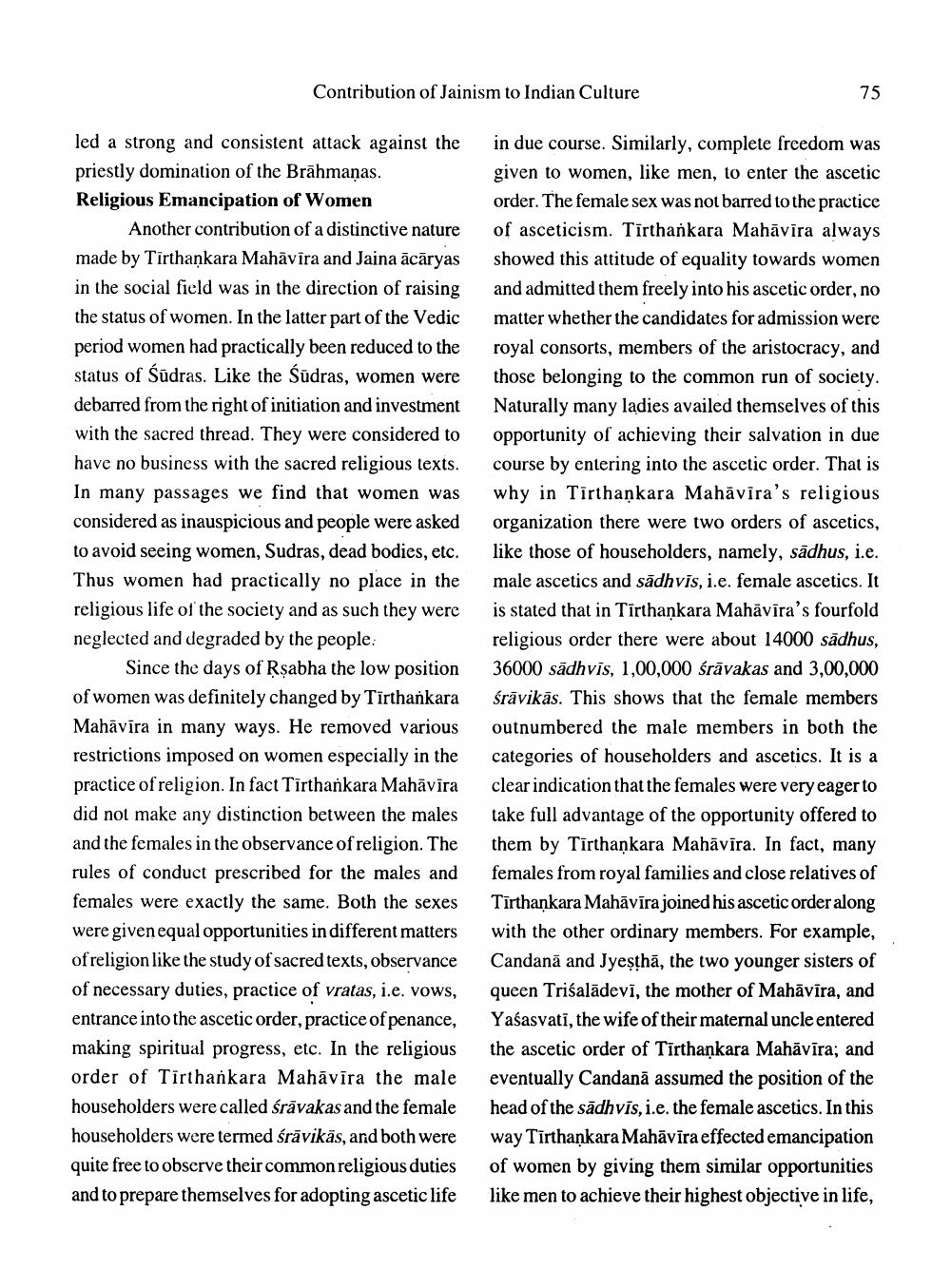________________
Contribution of Jainism to Indian Culture
75
led a strong and consistent attack against the priestly domination of the Brāhmaṇas. Religious Emancipation of Women
Another contribution of a distinctive nature made by Tirthankara Mahāvīra and Jaina ācāryas in the social field was in the direction of raising the status of women. In the latter part of the Vedic period women had practically been reduced to the status of Sūdras. Like the Sūdras, women were debarred from the right of initiation and investment with the sacred thread. They were considered to have no business with the sacred religious texts. In many passages we find that women was considered as inauspicious and people were asked to avoid seeing women, Sudras, dead bodies, etc. Thus women had practically no place in the religious life of the society and as such they were neglected and degraded by the people:
Since the days of Rsabha the low position of women was definitely changed by Tīrthankara Mahāvīra in many ways. He removed various restrictions imposed on women especially in the practice of religion. In fact Tīrthankara Mahāvīra did not make any distinction between the males and the females in the observance of religion. The rules of conduct prescribed for the males and females were exactly the same. Both the sexes were given equal opportunities in different matters of religion like the study of sacred texts, observance of necessary duties, practice of vratas, i.e. vows, entrance into the ascetic order, practice of penance, making spiritual progress, etc. In the religious order of Tirthankara Mahāvīra the male householders were called śrāvakas and the female householders were termed śrāvikās, and both were quite free to observe their common religious duties and to prepare themselves for adopting ascetic life
in due course. Similarly, complete freedom was given to women, like men, to enter the ascetic order. The female sex was not barred to the practice of asceticism. Tīrthankara Mahāvīra always showed this attitude of equality towards women and admitted them freely into his ascetic order, no matter whether the candidates for admission were royal consorts, members of the aristocracy, and those belonging to the common run of society. Naturally many ladies availed themselves of this opportunity of achieving their salvation in due course by entering into the ascetic order. That is why in Tirthankara Mahāvīra's religious organization there were two orders of ascetics, like those of householders, namely, sādhus, i.e. male ascetics and sādhvis, i.e. female ascetics. It is stated that in Tīrthankara Mahāvīra's fourfold religious order there were about 14000 sādhus, 36000 sādhvis, 1,00,000 śrāvakas and 3,00,000 śrāvikās. This shows that the female members outnumbered the male members in both the categories of householders and ascetics. It is a clear indication that the females were very eager to take full advantage of the opportunity offered to them by Tīrthankara Mahāvīra. In fact, many females from royal families and close relatives of Tīrthankara Mahāvīra joined his ascetic order along with the other ordinary members. For example, Candanā and Jyesthā, the two younger sisters of queen Trisalādevī, the mother of Mahāvīra, and Yasasvati, the wife of their maternal uncle entered the ascetic order of Tīrthankara Mahāvīra; and eventually Candanā assumed the position of the head of the sādhvis, i.e. the female ascetics. In this way Tīrthankara Mahāvīra effected emancipation of women by giving them similar opportunities like men to achieve their highest objective in life,




